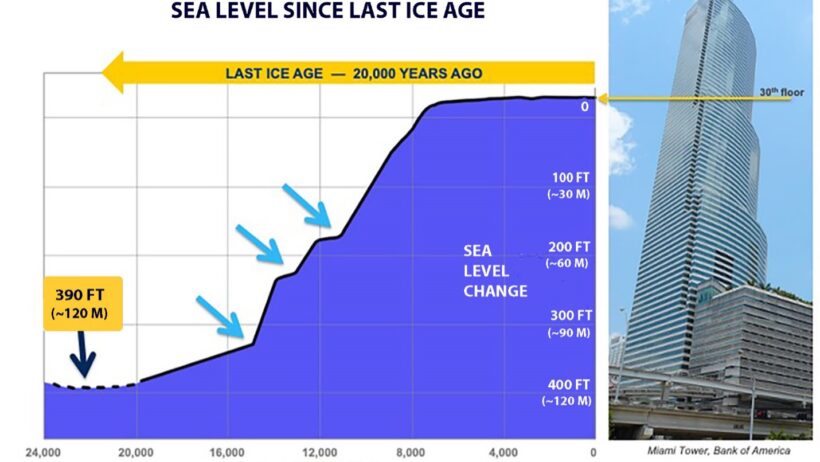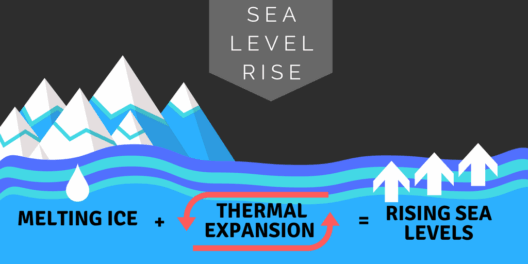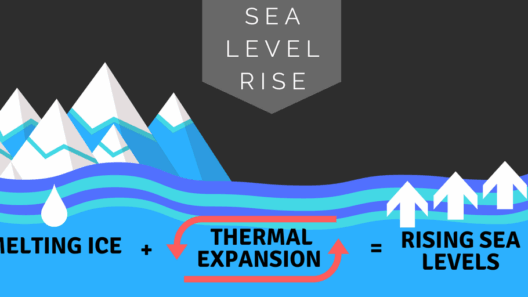The tumultuous rise of sea levels is a global phenomenon that has far-reaching implications, impacting ecosystems, economies, and communities. With the Earth increasingly warming, the inevitable question arises: how fast is the sea level really rising? This inquiry rolls off the tongue like a playful teasing challenge, often masked by the gravity of its consequences. To comprehend the intricacies of this issue, we will explore several factors contributing to the rising tides, the disparities across different regions, and what the future might hold.
Understanding the mechanics of sea level rise is essential. Two key drivers are responsible: thermal expansion of seawater and the melting of glaciers and ice sheets. As the planet’s temperature escalates, water takes up more space; this phenomenon, termed thermal expansion, is a significant contributor to rising sea levels. Simultaneously, the cryosphere—comprising glaciers and polar ice sheets—melts, releasing vast amounts of freshwater into the oceans. Together, these processes collectively fuel the increment in sea level that has been documented over the past century.
Delving into historical data, we see startling trends. According to research, global mean sea levels have risen about 8 to 9 inches since 1880, with rates increasing in recent decades. But hold on—what does this mean for future generations? Projections indicate that sea levels could rise by another 1 to 4 feet by the end of the century, depending on emission scenarios. This range introduces an element of uncertainty both to communities in low-lying areas and to coastal infrastructure, presenting them with a cataclysmic challenge.
While we grapple with these averages, it is equally vital to appreciate the regional variations. In some areas, particularly along the U.S. Atlantic Coast, the sea level is rising even faster—fundamentally caused by land subsidence and ocean currents interacting with the warming climate. Cities like Miami, New Orleans, and New York have witnessed portions of their coastlines ebbing away, while others are experiencing unprecedented storm surges exacerbated by rising tides. This localized rise raises questions about resilience and adaptation, challenging governments and local communities to rethink urban planning, insurance policies, and disaster management.
Evaluating the socio-economic implications of this rising tide reveals a complex tapestry of vulnerabilities. Communities that reside in coastal regions often have limited resources, leaving them ill-equipped to face the challenges brought on by higher sea levels. A poignant question arises: how can we mobilize these communities to embrace sustainability and resilience amidst such daunting circumstances? An increase in support for adaptable infrastructure—and the integration of green spaces, stormwater parks, and other innovative solutions—may provide pathways for coastal cities to mitigate the impacts of flooding and erosion.
The effects of sea level rise extend beyond just geographic displacement. Consider the impacts on biodiversity. Coastal ecosystems, such as mangroves and wetlands, serve as critical habitats for countless species. Unfortunately, as sea levels rise, these invaluable ecosystems are inundating, leading to loss of habitat, altered salinity levels, and increased competition for resources. The cascading effects on marine wildlife threaten not only their populations but also the fishing industries reliant on healthy marine ecosystems.
Equally sobering is the potential for social inequity exacerbated by sea-level rise. Low-income communities often bear the brunt of environmental changes, forced to evacuate homes and relocate further inland at substantial cost. A startling statistic emerges: by 2050, an estimated 150 million people could be displaced globally due to rising sea levels, primarily in developing countries. The challenge of climate justice looms large as we consider the equity of adaptation efforts and resource allocation to assist those most affected.
Addressing the conundrum of sea level rise requires a concerted effort on many fronts. Leaders, scientists, and citizens alike must adopt a multifaceted approach. From utilizing cutting-edge technology to monitor rising tides and predict future impacts to investing in green infrastructure and sustainable development, the route to resilience is complicated yet essential. Educational efforts, awareness campaigns, and community-driven initiatives foster a sense of urgency while highlighting the necessity for adaptive measures.
As the waves froth against the shores of our planet’s landmasses, we must ask: how can we collectively navigate the unpredictable waters of sea level rise? The answer lies in understanding the immediate need for action. Every increment of growth in sea level has tangible consequences for our ecosystems and communities, far removed from the realm of theoretical discourse. Therefore, the challenge becomes not just recognizing the threat but also conspiring to cultivate solutions that foster long-term resilience and sustainability.
In conclusion, the story of rising sea levels is one written across the canvas of our planet with urgency and depth. As we acknowledge the realities of climate change and its corrosive impacts, we fortify our collective resolve to confront these obstacles head-on. With intentionality, collaboration, and innovation, humanity can endeavor to rise alongside the tides, crafting a future that prioritizes both environmental stewardship and social equity.








